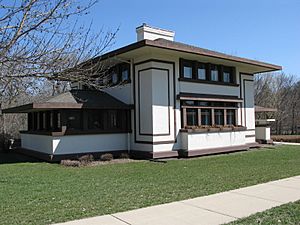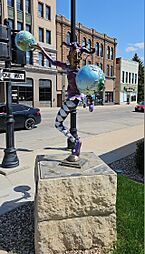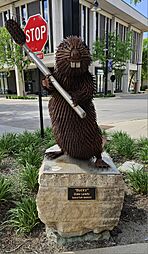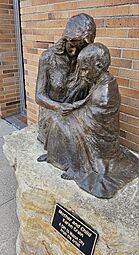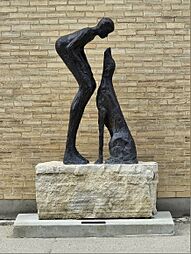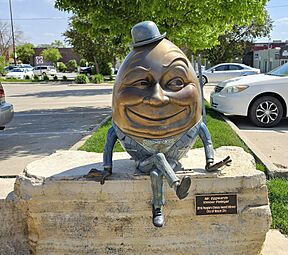Mason City, Iowa facts for kids
Quick facts for kids
Mason City, Iowa
|
|
|---|---|

Read clockwise, from top-left: Federal Avenue Plaza, East Park Band Shell, Park Inn Hotel by Frank Lloyd Wright, Meredith Willson House
|
|
| Nickname(s):
"River City"
|
|
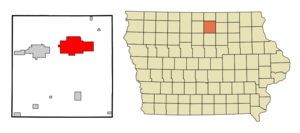
Location of Mason City, Iowa
|
|
| Country | |
| State | |
| County | Cerro Gordo |
| Area | |
| • Total | 28.16 sq mi (72.92 km2) |
| • Land | 27.86 sq mi (72.15 km2) |
| • Water | 0.30 sq mi (0.78 km2) |
| Elevation | 1,129 ft (344 m) |
| Population
(2020)
|
|
| • Total | 27,338 |
| • Rank | 16th in Iowa |
| • Density | 981.40/sq mi (378.93/km2) |
| Time zone | UTC−6 (Central (CST)) |
| • Summer (DST) | UTC−5 (CDT) |
| ZIP Codes |
50401, 50402, 50467
|
| Area code(s) | 641 |
| FIPS code | 19-50160 |
| GNIS feature ID | 458840 |
| Website | www.masoncity.net |
Mason City is a city in Iowa, United States. It's the main city in Cerro Gordo County. In 2020, about 27,338 people lived here. Mason City is famous for its music, unique Prairie School buildings, and being close to Clear Lake.
The city is part of a larger area that includes Worth County. You can find North Iowa Area Community College here. The Winnebago River flows through the southeast part of the city.
Contents
A Look Back in Time
The area where Mason City now stands was once a summer home for the Sioux and Winnebago Native American nations. The first settlement started in 1853. It was located where the Winnebago River and Calmus Creek meet.
The town had a few different names before "Mason City" was chosen in 1855. Some early names were Shibboleth and Masonic Grove. The name "Mason City" honors Mason Long, the son of one of the founders.
In 1854, John McMillin opened the first store. Dr. Silas Card started the first medical practice. Lizzie Thompson opened the first school in a log cabin in 1856. The United States Post Office Department began mail service in 1857. Mason City became the county seat in 1858. In 1870, Mason City officially became a town. Darius B. Mason was its first mayor.
Music in the Air
Mason City is known for its musical history. Meredith Willson, a famous composer, grew up here. He played in the Mason City Symphonic Band when he was in high school. Willson wrote the well-known musical The Music Man. Many characters in the show were based on people he knew from his childhood in Mason City. The city also has the Parker's Opera House.
City Layout and Weather
Mason City covers about 28.10 square miles (72.78 square kilometers). Most of this area is land, with a small part being water.
Climate
Mason City has a climate with warm summers. It can get quite cold in winter.
| Climate data for Mason City, Iowa (Mason City Municipal Airport,) 1991–2020 normals, extremes 1948–present | |||||||||||||
|---|---|---|---|---|---|---|---|---|---|---|---|---|---|
| Month | Jan | Feb | Mar | Apr | May | Jun | Jul | Aug | Sep | Oct | Nov | Dec | Year |
| Record high °F (°C) | 62 (17) |
66 (19) |
84 (29) |
93 (34) |
99 (37) |
103 (39) |
104 (40) |
101 (38) |
99 (37) |
95 (35) |
79 (26) |
69 (21) |
104 (40) |
| Mean maximum °F (°C) | 44.5 (6.9) |
48.0 (8.9) |
67.2 (19.6) |
82.5 (28.1) |
88.4 (31.3) |
92.9 (33.8) |
92.9 (33.8) |
90.5 (32.5) |
89.3 (31.8) |
81.7 (27.6) |
65.8 (18.8) |
48.5 (9.2) |
95.1 (35.1) |
| Mean daily maximum °F (°C) | 24.2 (−4.3) |
28.5 (−1.9) |
42.1 (5.6) |
57.5 (14.2) |
69.6 (20.9) |
79.6 (26.4) |
82.5 (28.1) |
80.2 (26.8) |
74.1 (23.4) |
59.9 (15.5) |
43.6 (6.4) |
29.7 (−1.3) |
56.0 (13.3) |
| Daily mean °F (°C) | 15.7 (−9.1) |
20.0 (−6.7) |
32.9 (0.5) |
46.0 (7.8) |
58.2 (14.6) |
68.5 (20.3) |
71.5 (21.9) |
68.9 (20.5) |
61.4 (16.3) |
48.2 (9.0) |
33.9 (1.1) |
21.6 (−5.8) |
45.6 (7.6) |
| Mean daily minimum °F (°C) | 7.2 (−13.8) |
11.4 (−11.4) |
23.6 (−4.7) |
34.5 (1.4) |
46.8 (8.2) |
57.3 (14.1) |
60.5 (15.8) |
57.6 (14.2) |
48.8 (9.3) |
36.6 (2.6) |
24.3 (−4.3) |
13.5 (−10.3) |
35.2 (1.8) |
| Mean minimum °F (°C) | −16.0 (−26.7) |
−10.6 (−23.7) |
0.5 (−17.5) |
18.7 (−7.4) |
31.9 (−0.1) |
44.2 (6.8) |
49.2 (9.6) |
46.2 (7.9) |
32.7 (0.4) |
20.1 (−6.6) |
6.1 (−14.4) |
−9.0 (−22.8) |
−19.4 (−28.6) |
| Record low °F (°C) | −31 (−35) |
−32 (−36) |
−28 (−33) |
6 (−14) |
22 (−6) |
36 (2) |
42 (6) |
35 (2) |
24 (−4) |
12 (−11) |
−16 (−27) |
−26 (−32) |
−32 (−36) |
| Average precipitation inches (mm) | 0.89 (23) |
1.22 (31) |
2.29 (58) |
4.15 (105) |
5.15 (131) |
5.39 (137) |
4.43 (113) |
3.79 (96) |
3.45 (88) |
2.53 (64) |
1.67 (42) |
1.29 (33) |
36.25 (921) |
| Average snowfall inches (cm) | 11.3 (29) |
10.0 (25) |
7.0 (18) |
3.0 (7.6) |
0.3 (0.76) |
0.0 (0.0) |
0.0 (0.0) |
0.0 (0.0) |
0.0 (0.0) |
0.4 (1.0) |
3.0 (7.6) |
9.4 (24) |
44.4 (113) |
| Average precipitation days (≥ 0.01 in) | 8.1 | 7.9 | 9.4 | 11.7 | 13.7 | 11.9 | 9.6 | 9.2 | 9.0 | 8.9 | 7.8 | 8.4 | 115.6 |
| Average snowy days (≥ 0.1 in) | 7.7 | 6.2 | 3.8 | 1.7 | 0.1 | 0.0 | 0.0 | 0.0 | 0.0 | 0.5 | 3.2 | 7.0 | 30.2 |
| Source: NOAA | |||||||||||||
People of Mason City
| Historical population | |||
|---|---|---|---|
| Census | Pop. | %± | |
| 1870 | 1,183 | — | |
| 1880 | 2,510 | 112.2% | |
| 1890 | 4,007 | 59.6% | |
| 1900 | 6,747 | 68.4% | |
| 1910 | 11,230 | 66.4% | |
| 1920 | 20,065 | 78.7% | |
| 1930 | 23,304 | 16.1% | |
| 1940 | 27,080 | 16.2% | |
| 1950 | 27,980 | 3.3% | |
| 1960 | 30,642 | 9.5% | |
| 1970 | 30,379 | −0.9% | |
| 1980 | 30,144 | −0.8% | |
| 1990 | 29,040 | −3.7% | |
| 2000 | 29,172 | 0.5% | |
| 2010 | 28,079 | −3.7% | |
| 2020 | 27,338 | −2.6% | |
| Iowa Data Center | |||
2020 Census Facts
In 2020, Mason City had 27,338 people. There were 12,271 households. About 23.3% of these households had children under 18. The average age in the city was 42.7 years. About 22.6% of residents were under 20 years old.
What Mason City Makes and Does
Mason City has many different types of jobs. These include jobs in making things, healthcare, money services, technology, and education. No single type of job or company is the only one in town.
The biggest employer is MercyOne North Iowa Medical Center. It's the largest hospital in the area. It serves 14 counties in northern Iowa.
Other big employers include companies that make doors, like Curries and Graham. There are also Woodhardbor Cabinetry Manufacturers, Principal Financial, and Cargill Kitchen Solutions. The Kraft Foods plant in Mason City makes all of the refrigerated ready-to-eat Jell-O pudding snacks for the country. Mason City is also a major place for making Portland cement. In 2007, Reyes Holding / Martin-Brower opened a distribution center here. It serves McDonald's in five states.
Arts, Culture, and Fun
The Charles H. MacNider Art Museum has a collection of American art. It also features the famous Bil Baird puppets and many ceramic pieces.
Music Man Square is near downtown. It has exhibits about Meredith Willson and The Music Man. You can see Willson's childhood home there. There's also a replica street from the musical.
Festivals and Events
Every year in late May or early June, Mason City holds the North Iowa Band Festival. This event celebrates the city's musical history. School bands from across the Midwest compete in a parade. The local high school bands, Mason City High School and Newman Catholic High School, perform but do not compete. Meredith Willson often came back to join the festival.
Famous Buildings
Mason City is well-known for its many Prairie School style buildings. The Rock Crest-Rock Glen Historic District has the largest group of these buildings in Iowa. Between 1908 and 1922, at least 32 houses and one business building were built in this style. Many of them are listed on the National Register of Historic Places.
The first two Prairie style buildings were the Dr. G.C. Stockman House (1908) and the Park Inn Hotel and City National Bank Buildings (1909–1910). Both were designed by Frank Lloyd Wright, a famous architect. The hotel and bank were the first buildings Wright designed in Mason City. Then, he designed the Stockman House for a neighbor.
Both the Park Inn Hotel and Stockman House were in bad shape for a while. But community groups saved them. In 1989, the Stockman House was moved to keep it from being torn down. It was then fixed up and opened to the public. The Park Inn Hotel was also restored and reopened as a hotel in 2011. It is the last hotel Wright completed that is still standing.
The Rock Glen and Rock Crest National Historic district is a group of homes along Willow Creek. It has the largest collection of prairie-style homes in a natural setting anywhere. Other architects like Walter Burley Griffin and Marion Mahony Griffin also designed homes here.
Mason City also has many Victorian, Craftsman, and Bungalow style homes. There are also historic business buildings from 1892 to 1940. The Mason City Public Library was designed in 1939. The Len Jus Building has a very rare metal front. It is now being fixed up by its new owner.
Art Around Town
Since 2014, Mason City has hosted River City Sculptures on Parade. This is an annual art walk where different sculptures are displayed. Each year, the city buys the most popular sculpture to add to its permanent collection.
- Selection of Sculptures
Sports in Mason City
Mason City has a history of sports teams, even though it's not a huge city.
The North Iowa Bulls are a junior ice hockey team. They started playing in 2011. The Bulls have won several league championships. They also won the Tier III National Championship in 2013 and 2015. In 2021, the Bulls moved up to a higher league. A new team, the Mason City Toros, took their place in the old league.
Mason City also had minor league baseball teams. These included the Mason City Cementmakers (1912) and the Mason City Claydiggers (1915–1917). They played at Hanford Park. The Mason City Bats also played baseball here in 1994.
Barry Alvarez, a famous college football coach, led Mason City High School to a state football championship in 1978.
The River City Rugby Football Club started in Mason City in 1972. The club plays in spring and fall. It competes against teams from Iowa, Minnesota, and Nebraska.
Learning in Mason City
Schools for Kids
The Mason City Community School District runs several schools:
- Harding Elementary School
- Hoover Elementary School
- Jefferson Elementary School
- Roosevelt Elementary School
- Lincoln Intermediate School (grades 5–6)
- John Adams Junior High School (grades 7–8)
- Mason City High School (grades 9–12)
- Mason City Alternative High School
- Madison Early Childhood Center
There are also private schools like Newman Catholic Elementary/Middle School, Newman Catholic High School, and North Iowa Christian School. Mason City is also home to the Worldwide College of Auctioning.
Colleges and Universities
Mason City has several places for higher education:
- North Iowa Area Community College
- A branch of Buena Vista University (on the NIACC campus)
- Purdue University Global
- Hamilton College, a business school, has been in the city since 1900.
Media and News
Movies and TV
Mason City is featured in the documentary film How Democracy Works Now. In the 1989 movie UHF, a character wears a Mason City t-shirt.
The city was the inspiration for the fictional town of River City, Iowa, in The Music Man. The musical was written by Mason City native Meredith Willson. The 1962 movie version had its first showing in Mason City.
Television Channels
| Channel | Callsign | Affiliation | Branding | Subchannels | |
|---|---|---|---|---|---|
| (Virtual) | Channel | Programming | |||
| 3.1 | KIMT | CBS | KIMT 3 | 3.2 3.3 3.4 |
MyNetworkTV ION Antenna TV |
| 6.1 | KAAL | ABC | KAAL 6 | 6.2 | This TV |
| 10.1 | KTTC | NBC | KTTC 10 | 10.2 10.3 10.4 10.5 |
CW+ Heroes & Icons Court TV True Crime Network |
| 15.1 | KSMQ | PBS | KSMQ | 15.2 15.3 15.4 |
MHz Worldview Create Minnesota Channel |
| 24.1 | KYIN | PBS | Iowa Public Television | 24.2 24.3 24.4 |
PBS Kids World Create |
| 47.1 | KXLT | FOX | FOX 47 | 47.2 47.3 47.4 47.5 |
MeTV Laff Escape Quest |
Radio Stations
| AM radio stations | ||||
|---|---|---|---|---|
| Frequency | Call sign | Name | Format | |
| 970 | KQAQ | Real Presence Radio | Catholic | |
| 1010 | KRNI | Iowa Public Radio | Public Radio | |
| 1300 | KGLO | News/Talk | ||
| 1490 | KRIB | Oldies | ||
| FM radio stations | ||||
|---|---|---|---|---|
| Frequency | Call sign | Name | Format | |
| 88.5 | KBDC | American Family Radio | Christian | |
| 90.7 | K2814BA (KHKE Translator) |
Classical | ||
| 91.5 | KNSM | Iowa Public Radio | Public radio | |
| 92.5 | K223AB (KJLY Translator) |
Christian | ||
| 93.9 | KIAI | The Country Moose | Country | |
| 97.9 | KCMR | Christian | ||
| 98.7 | KSMA | 98.7 KISS Country | Country | |
| 99.9 | KAUS | US Country 99.9 | Country | |
| 103.7 | KLKK | 103.7 The Fox | Classic rock | |
| 106.1 | KLSS | Star 106 | Top 40 | |
Newspapers
- Globe Gazette – daily newspaper
Getting Around Mason City
Public Transport
Mason City Transit offers bus services and on-demand rides around the city.
Roads
Most of Mason City is served by Iowa Highway 122 and U.S. Route 65. U.S. Route 18 now goes around the south side of the city. Interstate 35 is about eight miles to the west and also serves the city.
Trains
Mason City is home to the Iowa Traction Railway. This is one of the last electric railroads in the U.S. that still uses electric trains to move goods.
Canadian Pacific Railway and Union Pacific Railroad also serve Mason City.
Airport
The city has the Mason City Municipal Airport (MCW). You can fly with United Airlines from here. This airport is famous for a sad event. On February 3, 1959, early rock and roll stars Buddy Holly, Ritchie Valens, and The Big Bopper (J.P. Richardson) took off from this airport. They had just played a concert in nearby Clear Lake, Iowa. Their plane crashed a few miles west of the airport. This event is known as the Day the Music Died. All three musicians and the pilot, Roger Peterson, died in the crash.
Famous People from Mason City
- Barry Alvarez, former football coach and athletic director
- Bil Baird, a famous puppeteer
- Carrie Chapman Catt, a leader in the women's right to vote movement
- Walter Burley Griffin, an architect
- Meredith Willson, composer and playwright of The Music Man
Sister City
Mason City, Iowa, has a special connection with Montegrotto Terme, Italy. They became "Sister Cities" in 2005.
Images for kids
See also
 In Spanish: Mason City (Iowa) para niños
In Spanish: Mason City (Iowa) para niños


